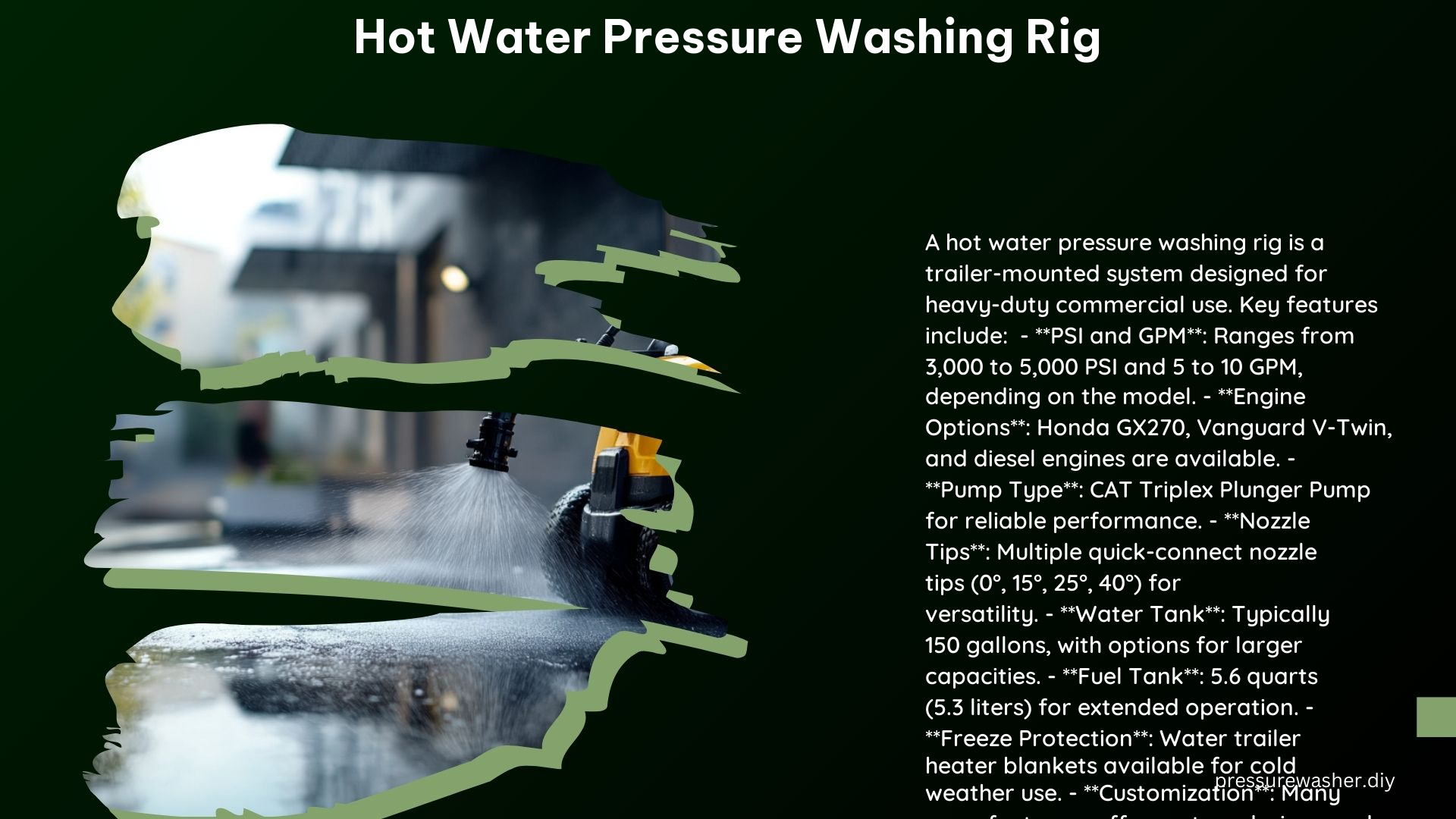Hot water pressure washing rigs are versatile and powerful tools that are indispensable for a wide range of commercial and industrial cleaning tasks. These mobile units offer unparalleled efficiency, customization, and performance, making them a must-have for professionals in the cleaning industry. In this comprehensive guide, we’ll delve into the key features, technical specifications, and maintenance considerations of these remarkable machines.
Key Features and Benefits
Mobility and Efficiency
Trailer-mounted hot water pressure washing rigs are designed for maximum mobility, allowing you to easily transport the unit to job sites, parking lots, building exteriors, and more. This mobility translates to increased efficiency, as you can quickly move the rig to where it’s needed most, saving time and reducing downtime.
The trailer-mounted design also offers stability and ease of transport, with single or tandem axle configurations to handle the weight of the water tank, engine, and other components. This ensures a smooth and secure ride, even on uneven terrain or job sites.
Customization Options
One of the standout features of hot water pressure washing rigs is the level of customization available. Manufacturers offer a wide range of options to tailor the rig to your specific needs, including:
- Hose Length: Ranging from 50 to 200 feet, the hose length can be customized to suit the size and layout of your job sites.
- Water Temperature: Adjustable water temperature, typically ranging from 180°F to 250°F, allows you to tackle a variety of cleaning tasks, from degreasing to sanitizing.
- Tank Capacity: Water tank sizes can vary from 150 to 500 gallons, ensuring you have the necessary volume for extended cleaning sessions without frequent refilling.
- Axle Type: Single or tandem axle configurations are available, depending on the weight and size requirements of your operation.
- Accessory Organization: Customizable storage and organization solutions for wands, nozzles, and other accessories help keep your rig tidy and efficient.
This level of customization ensures that your hot water pressure washing rig is perfectly suited to your unique cleaning needs, maximizing productivity and minimizing setup time.
Power and Performance
Hot water pressure washing rigs are designed for heavy-duty commercial and industrial use, with the power and performance to handle even the most demanding cleaning tasks. Typical specifications include:
- Pressure Range: 3,000 to 5,000 PSI, providing the high-pressure cleaning power required for tough jobs.
- Flow Rate: 3 to 10 GPM, ensuring a steady and consistent water flow for efficient cleaning.
- Engine Options: Common engine choices include the Honda GX270 and Vanguard V-Twin, known for their reliability and power.
- Pump Technology: Reliable triplex plunger pumps, such as those from CAT, deliver consistent and durable performance.
- Burner Systems: Advanced burner systems maintain the desired water temperature, even under heavy use, for optimal cleaning results.
These powerful components work in harmony to provide the cleaning performance and efficiency that professionals demand, making hot water pressure washing rigs a valuable asset for any cleaning operation.
Safety and Reliability
Ensuring the safety and reliability of hot water pressure washing rigs is a top priority for manufacturers. These units are built with features that protect both the operator and the equipment, including:
- Low Oil Shutdown: Automatic shutdown mechanisms prevent engine damage in the event of low oil levels, reducing the risk of costly repairs.
- Freeze Protection: Winterization features, such as the ability to purge water from the system, protect the rig from freezing temperatures and potential damage.
- Rugged Construction: Durable materials and robust design elements allow hot water pressure washing rigs to withstand the rigors of heavy-duty use and harsh environmental conditions.
By prioritizing safety and reliability, manufacturers ensure that hot water pressure washing rigs can be operated with confidence, minimizing downtime and maximizing the return on investment.
Technical Specifications

Pressure and Flow Rate
The pressure and flow rate capabilities of hot water pressure washing rigs are crucial for their performance and versatility. Typical specifications include:
- Pressure Range: 3,000 to 5,000 PSI, with the higher end of the range suitable for the most demanding cleaning tasks, such as removing heavy-duty grime, oil, and grease.
- Flow Rate: 3 to 10 GPM, with higher flow rates allowing for faster and more efficient cleaning, particularly on large surface areas.
The specific pressure and flow rate requirements will depend on the cleaning tasks at hand, and manufacturers often offer models with a range of options to accommodate different needs.
Engine and Pump
The engine and pump are the heart of a hot water pressure washing rig, responsible for generating the necessary power and water pressure. Common engine and pump configurations include:
- Engine Options: Honda GX270 and Vanguard V-Twin engines are popular choices, known for their reliability, power, and ease of maintenance.
- Pump Technology: Triplex plunger pumps from manufacturers like CAT are widely used, providing consistent and durable performance under heavy use.
The engine and pump work in tandem to deliver the cleaning power and performance that hot water pressure washing rigs are known for, ensuring efficient and effective cleaning results.
Tank Capacity and Fuel
The water tank and fuel tank capacities of hot water pressure washing rigs are important considerations for extended cleaning sessions and reduced downtime:
- Water Tank Capacity: Ranging from 150 to 500 gallons, the water tank size determines the duration of cleaning operations before refilling is required.
- Fuel Tank Capacity: Typically holding 5 to 10 quarts of fuel, the fuel tank ensures that the rig can operate for extended periods without the need for frequent refueling.
Some models may also offer the option of a diesel engine, which can provide additional power and fuel efficiency for particularly demanding cleaning tasks.
Axle and Construction
The axle and overall construction of hot water pressure washing rigs are designed to provide stability, durability, and ease of transport:
- Axle Configuration: Rigs can feature either single or tandem axle designs, depending on the weight and size requirements of the unit.
- Construction Materials: Durable materials, such as heavy-duty steel, are used in the construction of hot water pressure washing rigs to withstand the rigors of heavy-duty use and harsh environmental conditions.
The combination of the axle design and robust construction ensures that hot water pressure washing rigs can be safely and securely transported to job sites, while also providing a stable and reliable platform for cleaning operations.
DIY and Maintenance
Regular Maintenance
Proper maintenance is crucial for ensuring the longevity and peak performance of your hot water pressure washing rig. Regular maintenance tasks include:
- Filter Cleaning: Regularly cleaning the water filter helps to prevent clogging and maintain optimal water flow.
- Fuel Filter Replacement: Replacing the fuel filter at recommended intervals helps to ensure consistent engine performance and fuel efficiency.
- Routine Inspections: Performing regular inspections of the rig’s components, such as hoses, connections, and safety features, can help identify and address any potential issues before they become more serious.
By staying on top of these maintenance tasks, you can maximize the lifespan of your hot water pressure washing rig and maintain its cleaning power and efficiency.
Winterization
Preparing your hot water pressure washing rig for the winter months is essential to prevent freezing and potential damage to the system. The winterization process typically involves:
- Draining the System: Completely draining the water tank, hoses, and other components to remove any remaining water that could freeze.
- Compressed Air Purge: Using compressed air to blow out any residual water from the system, ensuring that no moisture is left behind.
- Protecting the Pump: Applying a pump protector or antifreeze solution to the pump to safeguard it from the effects of freezing temperatures.
By properly winterizing your hot water pressure washing rig, you can ensure that it’s ready to perform at its best when the warmer months return, minimizing the risk of costly repairs and downtime.
Customization and Upgrades
Hot water pressure washing rigs offer a wide range of customization and upgrade options to further enhance their capabilities and meet your specific cleaning needs:
- Accessory Additions: Users can add accessories such as specialized nozzles, wands, and hose reels to optimize the rig’s performance for different cleaning tasks.
- Engine Upgrades: Replacing the standard engine with a more powerful model can increase the rig’s pressure and flow rate capabilities, allowing it to handle even the toughest cleaning challenges.
- Tank Capacity Expansion: Upgrading to a larger water tank can extend the duration of cleaning operations, reducing the need for frequent refilling.
- Burner System Enhancements: Advanced burner systems can be installed to maintain consistent water temperatures, even under heavy use, for improved cleaning efficiency.
By taking advantage of these customization and upgrade options, you can tailor your hot water pressure washing rig to perfectly suit your business’s unique requirements, maximizing its performance and return on investment.
References
- Power Cleaning Systems: Trailer Pressure Washers – Equipment – Power Cleaning Systems
- Water Trailer: Mobile Pressure Washing Rig | Unit 95001 | Specs, Prices
- Power Line Industries: Power Line’s Pressure Washer
- Mud Dog Trailers: The Mud Dog Trailer
- BCE Cleaning Systems: Pressure Washer Trailer Packages – BCE Cleaning Systems
